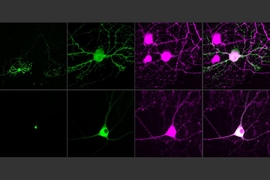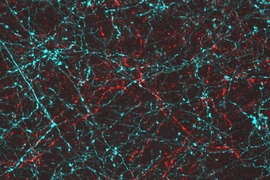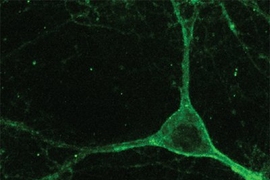Nearly 20 years ago, scientists developed ways to stimulate or silence neurons by shining light on them. This technique, known as optogenetics, allows researchers to discover the functions of specific neurons and how they communicate with other neurons to form circuits.
Building on that technique, MIT and Harvard University researchers have now devised a way to achieve longer-term changes in neuron activity. With their new strategy, they can use light exposure to change the electrical capacitance of the neurons’ membranes, which alters their excitability (how strongly or weakly they respond to electrical and physiological signals).
Changes in neuron excitability have been linked to many processes in the brain, including learning and aging, and have also been observed in some brain disorders, including Alzheimer’s disease.
“This new tool is designed to tune neuron excitability up and down in a light-controllable and long-term manner, which will enable scientists to directly establish the causality between the excitability of various neuron types and animal behaviors,” says Xiao Wang, the Thomas D. and Virginia Cabot Assistant Professor of Chemistry at MIT, and a member of the Broad Institute of MIT and Harvard. “Future application of our approach in disease models will tell whether fine-tuning neuron excitability could help reset abnormal brain circuits to normal.”
Wang and Jia Liu, an assistant professor at Harvard School of Engineering and Applied Sciences, are the senior authors of the paper, which appears today in Science Advances.
Chanan Sessler, an MIT graduate student in the Department of Chemistry; Yiming Zhou, a postdoc at the Broad Institute; and Wenbo Wang, a graduate student at Harvard, are the lead authors of the paper.
Membrane manipulation
Optogenetics is a tool scientists use to manipulate neuron activity, by engineering them to express light-sensitive ion channels. When those engineered neurons are exposed to light, changes in the flow of ions through the channels suppresses or boosts neuron activity.
“By using light, you can either open or close these ion channels, and that in turn will excite or silence the neurons. That allows for a fast response in real time, but it means that if you want to control these neurons, you have to be constantly illuminating them,” Sessler says.
The MIT and Harvard team set out to modify the technique so that they could generate longer-lasting changes in excitability, rather than transient activation or suppression of activity. To do that, they focused on altering the capacitance of the cell membrane, which is a key determinant of the membrane’s ability to conduct electricity.
When the capacitance of the cell membrane is increased, neurons become less excitable — that is, less likely to fire an action potential in response to input from other cells. When the capacitance is decreased, neurons become more excitable.
"The excitability of neurons is governed by two membrane properties: conductivity and capacitance. While many studies have focused on membrane conductivity executed by ion channels, naturally occurring myelination processes suggest that modulating membrane capacitance is another effective way of tuning neuron excitability during brain development, learning, and aging. So, we wondered if we could tune neuron excitability by changing membrane capacitance,” Liu says.
While a postdoc at Stanford University, Liu and his colleagues showed that they could alter neurons’ excitability by inducing them to assemble either conductive or insulating polymers in their membranes. In that study, published in 2020, Liu used an enzyme called peroxidase to assemble the polymers. However, that approach did not allow for precise control over where the polymers accumulated. It also posed some risk because the reaction requires hydrogen peroxide, which can damage cells.
To overcome those limitations, Liu’s lab at Harvard teamed up with Wang’s MIT lab to try a new approach. Instead of using peroxidase, the researchers made use of a genetically engineered light-sensitive protein that can catalyze the formation of polymers.
Working with neurons grown in a lab dish, the researchers engineered the cells to express this light-sensitive protein, known as miniSOG. When activated by blue wavelengths of light, miniSOG produces highly reactive molecules called reactive oxygen species. At the same time, the researchers expose the cells to building blocks of either a conducting polymer, known as PANI, or an insulating polymer, known as PDAB.
After several minutes of light exposure, the reactive oxygen species spur those building blocks to assemble into either PDAB or PANI.
Using a technique known as whole cell patch clamp, the researchers found that neurons with conducting PANI polymers became less excitable, while neurons with insulating PDAB polymers became more excitable. They also found that longer light exposures produced larger shifts in excitability.
“The advantage of optogenetic polymerization is the precise temporal control over polymerization reaction, which allows the predictable stepwise fine-tuning of membrane properties,” Zhou says.
Long-lasting changes
The researchers showed that the changes in excitability lasted for up to three days, which is as long as they could keep the neurons alive in their lab dish. They are now working on adapting this technique so that it could be used in slices of brain tissue and then, they hope, in the brains of animals such as mice or the worm C. elegans.
Such animal studies could help to shed light on how changes in neuron excitability affect disorders such as multiple sclerosis and Alzheimer’s disease, the researchers say.
“If we have a certain neuron population that we know has higher or lower excitability in a specific disease, then we can potentially modulate that population by transducing mice with one of these photosensitizing proteins that’s only expressed in that neuron type, and then see if that has the desired effect on behavior,” Wenbo Wang says. “In the near future, we’re using it more as a model to investigate those diseases, but you could imagine potential therapeutic applications.”
The research was funded by the Searle Scholars Program, the Stanley Center for Psychiatric Research at the Broad Institute, the Air Force Office of Scientific Research Young Investigator Program, the National Science Foundation through the Harvard University Materials Research Science and Engineering Center, and the Harvard Dean’s Competitive Fund for Promising Scholarship.











